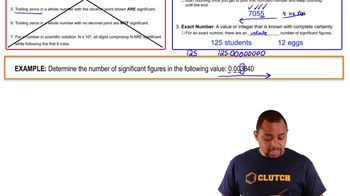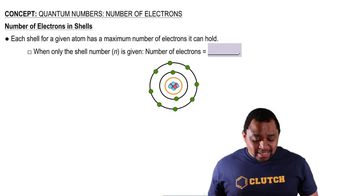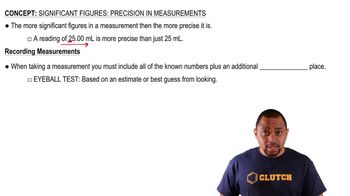Convert each temperature. a. 212 °F to °C (temperature of boiling water at sea level) b. 22 °C to K (approximate room temperature) c. 0.00 K to °F (coldest temperature possible, also known as absolute zero) d. 2.735 K to °C (average temperature of the universe as measured from background black body radiation)
Ch.1 - Matter, Measurement & Problem Solving
Chapter 1, Problem 8
Indicate the number of significant figures in each number. If the number is an exact number, indicate an unlimited number of significant figures. a. 318,857,056 (2014 U.S. population) b. 2.54 cm = 1 in. c. 11.4 g/cm³ (density of lead) d. 12 = 1 dozen.
 Verified step by step guidance
Verified step by step guidance1
Step 1: Identify the number of significant figures in the number 318,857,056. Since this is a measured value (2014 U.S. population), count all the digits as significant. There are no leading or trailing zeros to consider.
Step 2: Examine the conversion factor 2.54 cm = 1 in. This is a defined relationship between centimeters and inches, making it an exact number. Therefore, it has an unlimited number of significant figures.
Step 3: Look at the number 11.4 g/cm³, which represents the density of lead. This is a measured value, so count all the digits. The number has three significant figures.
Step 4: Consider the number 12 = 1 dozen. This is a defined quantity, meaning it is an exact number. Therefore, it has an unlimited number of significant figures.
Step 5: Summarize the findings: a. 318,857,056 has 9 significant figures, b. 2.54 cm = 1 in. has unlimited significant figures, c. 11.4 g/cm³ has 3 significant figures, d. 12 = 1 dozen has unlimited significant figures.
Key Concepts
Here are the essential concepts you must grasp in order to answer the question correctly.
Significant Figures
Significant figures are the digits in a number that contribute to its precision. This includes all non-zero digits, any zeros between significant digits, and trailing zeros in the decimal portion. Understanding significant figures is crucial for accurately reporting measurements and calculations in scientific contexts.
Recommended video:
Guided course

Significant Figures Example
Exact Numbers
Exact numbers are values that are counted or defined rather than measured, and they have an infinite number of significant figures. Examples include counts of objects (like 12 eggs in a dozen) or defined quantities (like 1 inch = 2.54 cm). Recognizing exact numbers is important for determining how many significant figures to report in calculations.
Recommended video:
Guided course

Number of Electrons in Shells
Measurement and Precision
Measurement refers to the process of quantifying physical quantities, while precision indicates the degree of reproducibility of measurements. In chemistry, understanding the precision of measurements helps in determining the appropriate number of significant figures to use, ensuring that results reflect the reliability of the data collected.
Recommended video:
Guided course

Significant Figures Precision
Related Practice
Textbook Question
5
views
1
rank
Textbook Question
Classify each statement as an observation, a law, or a theory.
a. All matter is made of tiny, indestructible particles called atoms.
b. When iron rusts in a closed container, the mass of the container and its contents does not change.
c. In chemical reactions, matter is neither created nor destroyed.
d. When a match burns, heat is released
34
views
1
rank
Textbook Question
Classify each statement as an observation, a law, or a theory. a. Chlorine is a highly reactive gas. b. If elements are listed in order of increasing mass of their atoms, their chemical reactivities follow a repeating pattern. c. Neon is an inert (or nonreactive) gas. d. The reactivity of elements depends on the arrangement of their electrons.
32
views
1
rank
